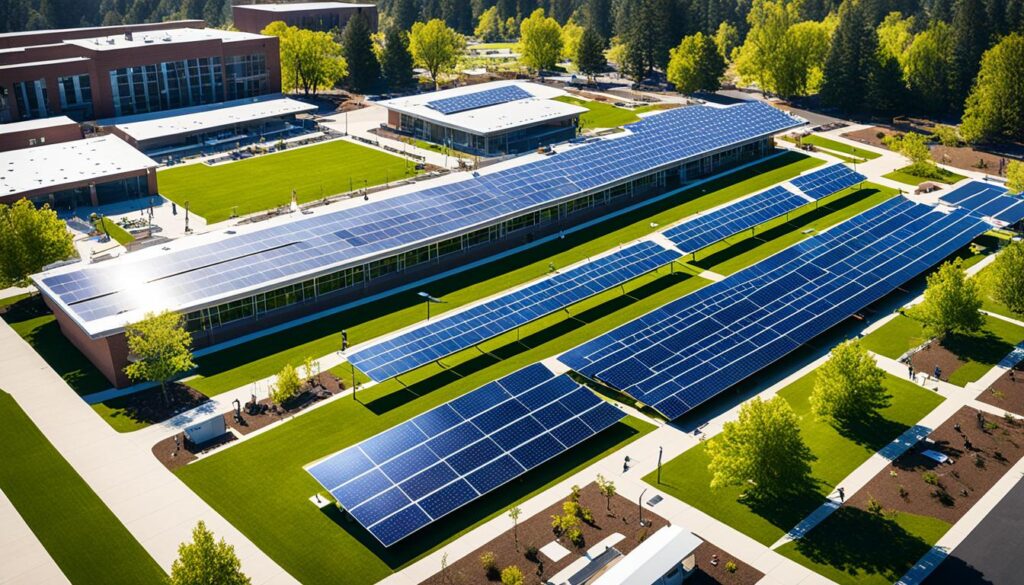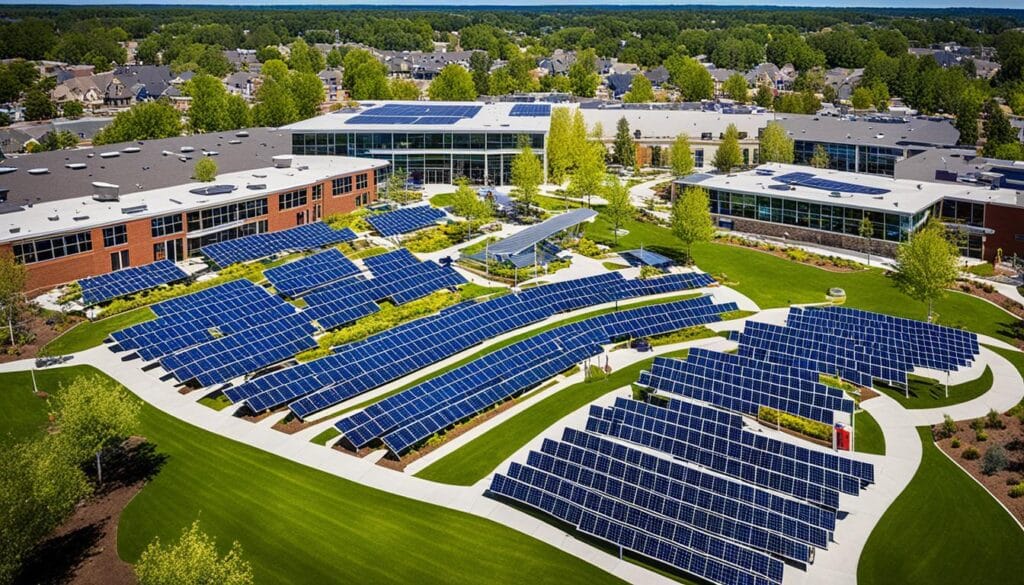
As a supporter of sustainable energy, I’m thrilled about SunPower Solar Solutions for Schools. Our goal is to introduce solar energy to schools, which enriches learning, cuts costs, and supports the environment. We design solar systems for schools that fit their teaching and energy needs perfectly.
Solar systems in schools are win-win. They lower what schools spend and become hands-on tools for teaching. Students see renewable energy and how to protect our planet in action. Solar-powered schools lead the way in teaching kids about clean energy and its global benefits.
Key Takeaways:
- SunPower Solar Solutions for Schools offers tailored solar solutions for schools.
- These solar setups cut costs and boost learning at the same time.
- Students learn about clean energy and saving the environment with solar power.
- Solar energy turns schools into examples, teaching kids about the value of green energy.
- The program aims to teach, equip, and inspire students with solar energy.
Transforming Education with Solar Power Technology
Solar power technology takes energy from the sun and turns it into electricity. It does this through special panels. This energy source is clean and sustainable. It powers our classrooms, lights, and tech at schools that use it.
Solar power has changed things for the better in many schools, especially those in faraway places. These schools now have electricity and online learning tools, thanks to solar energy. Students can study more, even after dark, because of this.
The power of the sun has broadened schools’ use of technology. This gives students more ways to learn. Now, they have better tools to help them learn more.

“Solar power has made our school a lively place that cares for the earth. Our students are learning about clean energy and helping to protect our planet.” – Principal of A Solar-Powered School
Solar schools also create chances for students to learn together. With solar power, everyone can use digital learning and talk to other students online. This makes schools more lively and open to everyone.
How Solar Energy Works
Let’s look at how solar energy works. Solar panels soak up the sun’s light and turn it into electricity. This electricity gets turned into a form schools can use by an inverter. It’s then sent out to power up all the educational tools and lights at school.
This way, solar power stops the need for harmful fossil fuels. It helps make our planet cleaner for the future.
The Impact on Education
Solar power has greatly helped education. It makes schools a better place for learning by ensuring there’s always power. This is very important in far off places. Solar energy means everyone can learn, no matter where they are.
It also helps bridge the gap in technology. Computers, internet, and online study materials are now open to students. This means students now have the skills for future jobs, thanks to technology.
“Solar energy brightens our school and community. Our students get to use computers and explore endless learning possibilities. It has really changed their lives.” – Teacher at a Solar-Powered School
But the change isn’t just inside the school. Solar power teaches students to take care of the planet. They learn how important clean energy is for the future.
| Impact on Education | Solar Power Technology |
|---|---|
| Extended learning hours | Access to electricity beyond sunset |
| Digital horizons | Access to online resources and interactive learning platforms |
| Community engagement | Collaboration with peers globally |
| Environmental awareness | Instilling a sense of sustainability |
Brightening Lives and Communities with Solar Energy
Solar energy is changing the game in remote villages. It’s boosting growth and wealth through solar-powered businesses. The lights from solar power make streets lively. This draws in more people at night, spurring business and local markets, which helps the economy.
“Solar energy has been a game-changer for our village. With the lights dotting our streets, more people come out at night, and we’ve seen a significant increase in business activity. It has truly energized our community.” – Maria Lopez, owner of a solar-powered cafe
In addition, solar energy is transforming small industries. It offers a clean, sustainable power source. Businesses are using solar-powered machines to work in a way that’s kinder to the planet. This is good for the environment and helps these businesses last longer.
Solar energy is also rejuvenating community spaces. With plenty of light, these areas become perfect for social activities and events. Parks now offer safe and welcoming spots for everyone to enjoy.

Community centers as catalysts for development
Community centers, now powered by solar, do more than just light up. They’ve become places for people to come together. Events and meetings there help build stronger communities and friendships. They also offer a chance to learn and grow together.
Solar power breathes new life into these community hubs. It’s helping villages shine brighter and be greener. The benefits of solar power go well beyond money. It touches lives, strengthens communities, and sets the stage for future growth.
| Impact of Solar Energy on Villages | Benefits |
|---|---|
| Economic Growth | – Boosts local businesses and night markets – Increases business activity and revenue – Generates employment opportunities |
| Environmental Sustainability | – Minimizes carbon footprint – Reduces reliance on fossil fuels – Preserves natural resources |
| Community Engagement | – Fosters social gatherings and cultural events – Promotes inclusivity and social cohesion – Provides spaces for connection and interaction |
| Empowerment | – Enables local progress and self-sufficiency – Inspires innovation and entrepreneurship – Enhances quality of life |
Conclusion
Solar schools are changing education in far-off places by offering dependable, green energy. These schools go beyond normal buildings. They stand as symbols of hope and progress for forgotten communities. They use eco-friendly methods and smart design. This makes them sources of inspiration for a better, greener world.
These schools don’t just teach; they transform life in remote areas. They help local businesses grow and create new jobs. Plus, with their clean energy, they give people places to meet, hold events, and bond. They also teach kids to take care of our planet.
To really change things, we need more solar schools everywhere. This means working together, governments, NGOs, and businesses alike. With partnerships, we can find the money to spread solar schools to more places. Helpful rules and rewards can speed up how fast we use solar energy in schools.
By making solar schools more common, we can make the future brighter and cleaner for everyone. Let’s use the sun to light up minds, lift up communities, and fuel sustainable growth. Together, we can ensure every kid gets a good education and lives in a world filled with clean energy.






